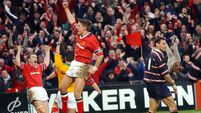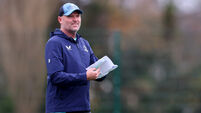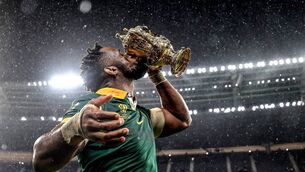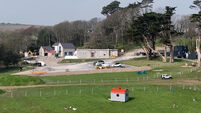Gary Halpin obituary: Ireland has produced no player more widely loved on both sides of the Irish Sea

Gary Halpin pictured in 2019. Photo: Ryan Byrne
The longest missile Gary Halpin unleashed in the global arena flew for 63.08 metres across Rome’s Olympic Stadium during the 1987 World Athletics Championships. The scud landed with a thud some way short of rearranging the podium reserved for the three best hammer throwers on the planet.
In retrospect, it could be said that the 21-year-old from Kilkenny via the University of Manhattan was only warming up for a different event in a different sport on a different continent. Eight years later in Johannesburg he went suitably ballistic over the impact his guided strike had on the supposedly indestructible All Blacks.
“I dined out on it like a Lord,” he once said. “I loved telling the story. You’d embellish it a bit every time and they’d buy you another beer.”
Gary Halpin’s sudden death on Wednesday, ten days after his 55th birthday, lends the tale of his only Test try and its immediate aftermath a poignancy felt by all who knew him. Ireland may have produced many more decorated rugby players but none more widely loved on both sides of the Irish Sea.
Ireland, as coached by Gerry Murphy and captained by Cork’s Terry Kingston, were a mere seven minutes into the 1995 Rugby World Cup when a frenzied Halpin achieved something over a few metres which the vast majority can only do in their dreams. He caused New Zealand’s defence to part like the Black Sea.
Like a rocket blasting off the launch-pad, he seized Michael Bradley’s tapped penalty at full fury barely 10 metres from the line. Jamie Joseph fell to the side, No. 8 Mike Brewer staggered backwards and the Australian referee blew for the try but Halpin hadn’t quite finished.
Running back with ecstatic team-mates, he suddenly remembered that the All Blacks enjoy a little afters. He turned round and raised the biggest finger of each hand in a salute which left little doubt as to the screaming nature of the message: “Don’t mess about with us.”
On that Saturday, May 27, 1995, Sean Fitzpatrick became the most-capped All Black of all. Only Halpin would have fully appreciated the delicious irony that his blockbuster had reduced the revered hooker to little more than a stumbling bystander, not that Ireland’s manager, Noel Murphy, appreciated the two-fingered salute.
“Sean Fitzpatrick had been winding us up, calling us Paddies,” he said. “And I couldn’t really believe I’d actually scored a try. It was a rather stupid thing to do (the gesture, not the try) being a teacher and it’s kind of embarrassing because I’ve gone on to meet a lot of those All Blacks since.
“In that competition those guys were sold to us as almost unstoppable. That was the first time I faced the Haka. They get a real psychological advantage over us. Why can’t we do something like that? Riverdance was big at the time.”

The prospect of Terry Kingston’s outsiders somehow managing to give the odds-on favourites a run for their money lasted for some 20 minutes before it vanished like a mirage. Just as Halpin had scored his first try, so a novice New Zealander did likewise except that he kept scoring ad infinitum.
Jonah Lomu, warming up for his four-try steam-rollering of England in the semi-final, bounced one Irish defender out of his way en route to giving the All Blacks a lead they would never lose in cruising home 43-19.
“I side-stepped Lomu three times during the course of that game,” Halpin said in an interview with . “The problem was that he was the one carrying the ball…
“You cannot believe how much South Africans hate New Zealanders. After that World Cup, I took a trip round South Africa and Zimbabwe. I couldn’t go into a pub and put my hand in my own pocket, the South Africans loved the whole thing that much. Andy Warhol talked about 15 minutes of fame and that was mine. I must have put on two stone in weight.”
Halpin spent virtually the entire last decade of the century in England, the majority of it at London Irish. They had elevated him to the captaincy when an ambitious young English coach took over during the year before Halpin socked it to the All Blacks.
His name was Clive Woodward of England World Cup-winning fame, of whom a friend once said: “Clive had so many ideas about coaching and man-management, especially in the early years, that he’d give you up to 20-a-day. The trick was to spot the really good one.”

Still the only European coach to have won the holy grail, Woodward paid a warm tribute to the fallen London Irish leader of yesteryear.
“It came as such a huge shock,’’ he said. “Gary was a great athlete and a great player, a larger-than-life character on and off the pitch.
“When I joined the club, he was thinking: ‘What’s this Englishman doing coming into a hotbed of Irish rugby?’ I told him right away: ‘Gary, I’m going to make this team Irish.’
“I warmed to him and he warmed to me. There were some funny conversations, like the time I decided to drop the orthodox numbers on the players’ jerseys and replace them with numbers based on the initial of a surname and where it came in the alphabet.
“I’d say: ‘Gary, you play and think like a prop because you’re No. 3, in the same way Conor O’Shea plays and thinks like a full-back because he’s No. 15.’ I want players to be multi-skilled so they can play all over the pitch so the H for your surname means you’ll be wearing seven.
“Gary stared at me. ‘You’re coaching London Irish. But you’re the boss. Ok, we’ll do it.’
“He was fantastic, just as he was throughout his teaching career. He taught my two boys, Joe and Freddie, at the Oratory School. He was a great teacher and coach. They loved him.’’
Gary Halpin, born February 14, 1966, had returned to Ireland to take up an appointment as head of boarding at Cistercian College, Roscrea.
He is survived by his wife, Carol, and three children.
“He made everybody feel great. He was everybody’s friend. He was everybody’s hero. You couldn’t but love him.”
“Really sad waking up to the news of Gary Halpin’s passing. What a character he was. A hilarious storyteller & the life and soul of any team he was part of. Thoughts are with his family.”
“He was so fast for such a big man. His hit in the scrum was incredible because he was a power athlete. I’m bald because of him, because he shaved my hair off the first time. He was a barrel of fun.”
"One of my favourite players when I was a kid. You need to be a bit mental to give the [All Blacks] the finger after scoring a try. Ballsy."
“What a lovely man he was and a wonderful character. Sincere condolences to all his family and friends.”
“Heartbroken at the news that Gary Halpin has died. A great athlete representing Ireland at hammer throwing & rugby. The best sense of humour & the funniest man I have ever coached. Off the field a gentleman & great family man. The world today is a lesser place. RIP Gary.”
"In recent years Gary had maintained an involvement with the game both through his work as Head of Boarding in Roscrea College where his commitment and positivity was highly respected by all who engaged with him and in Kilkenny RFC where he was Scrum Coach.”











